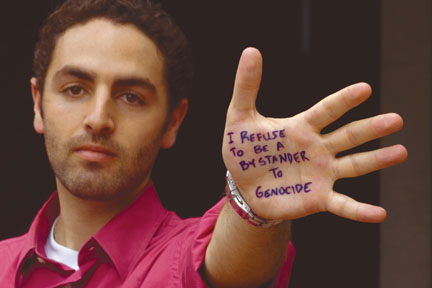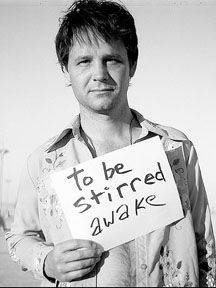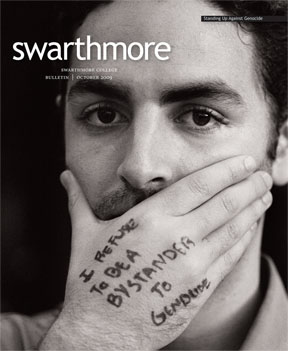In the Face of Genocide
Called to action by death in Darfur, the Genocide Intervention Network, led by Mark Hanis ’05, stands up against genocide around the world.

Mark Hanis ’05 answered the question “Why do you do what you do?" on his hand as part of the "wdydwyd? Project," a worldwide interactive art project. You can answer for yourself at www.wdydwyd.org. (On the Bulletin cover: Hanis, co-founder of the Genocide Intervention Network. Photograph by Tony Deifell for project “Why Do You Do What You Do?” Used with permission of the Echoing Green Foundation.)
The grandchild of four Holocaust survivors, Mark Hanis ’05 grew up in Quito, Ecuador, where he attended synagogue—the only one in the country—in a community that included other survivors. Showing the numbers tattooed on their arms, the elders told the temple’s children to never forget and never let the atrocities of genocide happen again. Hanis took them at their word and has held firm to their injunctions ever since.
When he was a student at Swarthmore, the edicts of his elders, combined with the notion of ethical intelligence that imbues campus life, compelled Hanis to spend spring semester 2003 in Sierra Leone, where he helped the Special Court there indict Charles Taylor, warlord and former president of Liberia, for crimes against humanity during the Liberian civil wars.
Back on campus, one evening, Hanis read about the genocide in Darfur. Already familiar with mass killing and its consequences, Hanis says he could not sit passively by and let it happen again, no matter how far away these atrocities were occurring. “If you saw a 6-year-old on your block fall or be pushed and need assistance, you’d run for help, you’d call 911. No one would question you for that, and if you didn’t help, people would say, ‘What’s wrong with you? How could you stand there and do nothing?’ To me, the same motivation should apply to helping people in the face of genocide and mass atrocities,” Hanis explains.
That night in 2003 marked the birth of the organization that was to become the Genocide Intervention Network, whose influence is now felt worldwide. Hanis and a group of friends, including Andrew Sniderman ’07 and Sam Bell ’05, spent many hours in McCabe Library, skipping classes to research Darfur. They discovered Samantha Power’s book A Problem from Hell: America and the Age of Genocide and came away with two goals: to raise money to protect civilians and to organize politically. With a phone line arranged for by Maurice Eldridge ’61, duct-taped computers from ITS, and space in the basement of the train station—then being used by the Lang Center for Civic and Social Responsibility—the group started the Genocide Intervention Fund. Fueled by an urgency that overshadowed graduation requirements, they skipped more classes to go to Boston and enlist Power, a professor at Harvard University’s Kennedy School of Government, as a resource. At one point, Hanis accidentally guessed Bill Gates’s personal e-mail address while searching for a notable sponsor to lend credibility to an op-ed piece he wanted to publish. That led to Microsoft contacting Swarthmore to find out how Hanis had hacked into their system. Their efforts proved beneficial as the group steadily raised a quarter million dollars for civilian protection in Darfur.
With the first goal—fundraising—well underway, Hanis and three other members of the group moved to Washington, D.C., after graduation. Fund became Network, and they kept running with the momentum they had generated. Hanis says of the transition, “We were already a registered nonprofit, 501(c3) company—so the move to D.C. wasn’t that tough.” Although some doubted the inexperienced group’s abilities, Hanis recalls the many experts they attracted as a result of their novel approach to abolishing genocide.
“We had an advisory board that included John Prendergast and Gayle Smith—both of them had worked at the National Security Council for Clinton—and the first ambassador for war crimes David Scheffer. As we developed expertise, we were guided by the members of a high-caliber advisory board who were eager to help us.”

The Darfur disaster inspired Hanis and others to organize against genocide while they were students.
The students’ entrepreneurial approach attracted influential donors as well, including the Omidyar Foundation, a charitable agency started by the wife of the founder of eBay. In 2004, Omidyar made a generous contribution that allowed what was now called GI-NET to obtain office space, hire a staff, and launch programs. “A lot of people who would normally just put us in the same bucket as another do-good charity really stopped to take a closer look at what we were doing and offer support,” Hanis says.
In 2006, Hanis was awarded Echoing Green and Draper Foundation fellowships that provided funding, training, and access to networks of social leaders. In 2008, he was named an Ashoka Fellow, and, in early 2009, the World Economic Forum named him a Young Global Leader. “The fellowships have been amazing resources in various ways. Each has a professional staff that is always there to mentor or advise, so I didn’t have to start from scratch,” Hanis says.
Hanis finds himself fueled by what he calls the “two-sided coin” of genocide. “It’s the urgency of the despair—people are being systematically exterminated for who they are. I find that to be an extremely compelling reason to give my time and attention. On the other side, what keeps me going is the possibility that we can end genocide. It’s an extremely empowering feeling to think that we can abolish genocide.”
With the goal of politicizing the movement against genocide, the GI-NET team began to develop consequences for inaction. They launched DarfurScores.org, an online scorecard that tracks politicians’ actions in response to genocide, such as sponsoring legislation or visiting Darfur. To facilitate communication between citizens and their representatives, the team recruited Sherry Bellamy ’74 and Gerrit Hall ’04 to create 1-800-GENOCIDE, “the 911 of stopping genocide,” according to Hanis. These tools help “democratize the fight to end genocide,” Hanis says, by providing pertinent information and making political accountability accessible. To further extend advocacy and education, GI-NET merged with STAND (Students Taking Action Now–Darfur) and expanded the organization from 200 chapters to now more than 800 chapters on college and high school campuses across the country.
After start-up years marked by rapid success, GI-NET has reached its stride and is maturing as an organization. This year, GI-NET launched the inaugural class of a training program—the Carl Wilkens Fellowship Program. “I think people saw us in the first couple years as just recruiting, training, and organizing students,” Hanis says, “So the big step in 2009 is to expand the demographic we’ve been organizing to include non-students.” The fellowships provide training in areas such as volunteer recruitment, conflict history, and legislative policy, and the program aims to create a network of grassroots activists. The inaugural class has 20 fellows, but their goal is to have one fellow in each of the 435 congressional districts. (One such fellow has already helped with the passage of a contract prohibition bill in Georgia.)
In May, GI-NET launched the Conflict Risk Network (CRN) to educate investors on the corporate practices of companies in which they invest. The CRN broadens GI-NET’s divestment campaign in Sudan, which has already successfully influenced divestments by 60 colleges or universities and 27 states. Additionally, 12 companies have pulled out or altered their behavior. Hanis notes the relative rapidity of success in this area: “The divestment campaign against apartheid in South Africa took decades. We’re seeing a lot more movement in the speed and depth of our divestment program in Sudan.” The launch of the CRN reflects GI-NET’s transition over the years from an organization that focuses solely on Darfur to one that keeps watch over multiple areas of conflict. Hanis and GI-NET’s director of protection, Chad Hazlett, penned an op-ed in The Washington Post on July 18, highlighting American responsibility in Iraq if ethnic violence re-emerges. In the end, Hanis and GI-NET are moving to “get people to go beyond being Darfur advocates and really become anti-genocide advocates,” he says.

In the end, Hanis and GI-NET are moving to “get people to go beyond being Darfur advocates and really become anti-genocide advocates,” he says.
The truly innovative twist to GI-NET’s mission lies in its perspective on genocide. Hanis points out that genocide “isn’t a natural disaster, where we have to brace for a hurricane or a tsunami. We can proactively stop the people from being killed, tortured, and gang-raped. We can stop them from being displaced from their homes.” GI-NET is firmly committed to protecting civilians by funding programs that have the specific goal of protection, rather than channeling the money they raise to food or medical aid. One such project in Burma provides villages with radios and training so that villagers can receive advance warning of imminent attacks and use that time to flee.
Hanis combines this perspective with an eye for technological innovation. “We’re surrounded by Web 2.0 and many innovative technologies, and we embrace them,” he says. The latest project involves a surprising way to donate: text messaging. The donation appears on the sender’s cell phone bill at the end of the month. “People will literally, while I’m de-scribing it, take out their phones, text ‘protect’ to 90999, and before I’ve finished talking about what people can do, the majority of the audience has already donated $5,” Hanis says.
Hanis hopes that GI-NET will eventually be able to shift its focus to preventing genocide before it happens. He intends to remain with GI-NET, building and maintaining a permanent anti-genocide constituency, until genocide is abolished. “This is a huge gap that needs to be filled,” as he says. “Hopefully, this will happen sooner rather than later, and if we can help check off that box, then that will be a time when I’ll see what else I can do.”
With detailed information about genocide and mass atrocities in eight areas of the world at his fingertips, Hanis can readily make suggestions on how every citizen can become involved in stopping those acts. In fact, he spends three weeks out of every month doing just that, traveling around the country, speaking to potential donors and engaging the media with GI-NET’s mission and latest accomplishments. Hanis’s answers have the practiced polish of a veteran public speaker, and the gravity with which he speaks reflects the urgency of his topic. His tone changes only briefly from its steady instruction, when speaking about himself. “I spend many more than 80 hours a week working to advance our mission,” he says with a laugh that quickly subsides.
Though Hanis, who currently serves as president of the organization, works almost every waking moment, he has friends by his side to make sure he goes out every once in a while. “I’ve been fortunate that a lot of my colleagues—like Sam Bell, GI-NET executive director—are my closest friends,” Hanis says. “I certainly recognize that there might be a better work-life balance for myself.”
Despite the many hours that Hanis devotes to GI-NET, he emphasizes that fighting genocide does not need to be a full-time job for everyone. “Literally, for five minutes every day, people could dramatically change the way the United States responds to preventing genocide,” Hanis points out. “They could do it without even having to stand up. You’ve got 1-800-GENOCIDE, you can text ‘protect,’ and if everyone did that—there’s no question—we would abolish genocide in our lifetime.”
Katie Becker is a senior psychology major and Bulletin intern.
 Entrepreneur and media maker Tony Deifell, who shot this issue’s cover image, is president of Q Media Labs. His book Seeing Beyond Sight features photographs made by blind teenagers whom he taught. Deifell’s “wdydwyd?” project (www.wdydwyd.org) has led to collaboration with artists worldwide. He lives on a houseboat in San Francisco.
Entrepreneur and media maker Tony Deifell, who shot this issue’s cover image, is president of Q Media Labs. His book Seeing Beyond Sight features photographs made by blind teenagers whom he taught. Deifell’s “wdydwyd?” project (www.wdydwyd.org) has led to collaboration with artists worldwide. He lives on a houseboat in San Francisco.
 Email This Page
Email This Page
January 21st, 2010 3:55 pm
What about the genocide of the Palestinians? Mr.Hanis, the grandson of four holocaust survivors, doesn't mention the genocide of the Palestinians by Israel.
Sounds very dramatic to me..